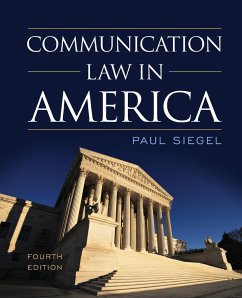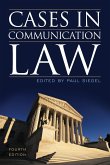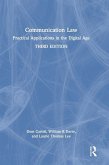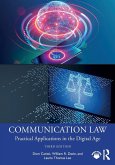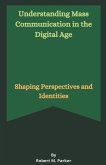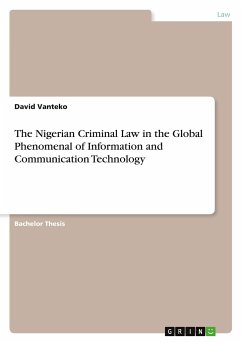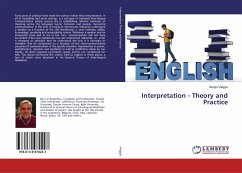Paul Siegel
Communication Law in America
Paul Siegel
Communication Law in America
- Broschiertes Buch
- Merkliste
- Auf die Merkliste
- Bewerten Bewerten
- Teilen
- Produkt teilen
- Produkterinnerung
- Produkterinnerung
Communication Law in America is a comprehensive, easy-to-follow overview of the complicated ways in which U.S. law determines who may say what to (and about) whom. It covers the usual content- libel, invasion of privacy, copyright and trademark, access to government information, advertising, electronic media- all the while giving readers a sense of how and why this country has come to weigh freedom of speech above competing freedoms far more often than in other Western democracies. This fourth edition of the well-received text boasts over 300 new citations, including discussion of a dozen U.…mehr
Andere Kunden interessierten sich auch für
![Cases in Communication Law Cases in Communication Law]() Paul SiegelCases in Communication Law78,99 €
Paul SiegelCases in Communication Law78,99 €![Communication Law Communication Law]() Dom CaristiCommunication Law184,99 €
Dom CaristiCommunication Law184,99 €![Communication Law Communication Law]() Dom CaristiCommunication Law123,99 €
Dom CaristiCommunication Law123,99 €![Communication and Music in Social Interaction Communication and Music in Social Interaction]() Jake HarwoodCommunication and Music in Social Interaction65,99 €
Jake HarwoodCommunication and Music in Social Interaction65,99 €![Understanding Mass Communication in the Digital Age Understanding Mass Communication in the Digital Age]() Robert M. ParkerUnderstanding Mass Communication in the Digital Age20,99 €
Robert M. ParkerUnderstanding Mass Communication in the Digital Age20,99 €![The Nigerian Criminal Law in the Global Phenomenal of Information and Communication Technology The Nigerian Criminal Law in the Global Phenomenal of Information and Communication Technology]() David VantekoThe Nigerian Criminal Law in the Global Phenomenal of Information and Communication Technology47,95 €
David VantekoThe Nigerian Criminal Law in the Global Phenomenal of Information and Communication Technology47,95 €![Interpretation - Theory and Practice Interpretation - Theory and Practice]() Sergio ViaggioInterpretation - Theory and Practice47,99 €
Sergio ViaggioInterpretation - Theory and Practice47,99 €-
-
-
Communication Law in America is a comprehensive, easy-to-follow overview of the complicated ways in which U.S. law determines who may say what to (and about) whom. It covers the usual content- libel, invasion of privacy, copyright and trademark, access to government information, advertising, electronic media- all the while giving readers a sense of how and why this country has come to weigh freedom of speech above competing freedoms far more often than in other Western democracies. This fourth edition of the well-received text boasts over 300 new citations, including discussion of a dozen U. S. Supreme Court decisions handed down since the previous edition. The text also offers a new section on how the First Amendment applies to special populations, including students, government employees in general, and the military in particular.
Hinweis: Dieser Artikel kann nur an eine deutsche Lieferadresse ausgeliefert werden.
Hinweis: Dieser Artikel kann nur an eine deutsche Lieferadresse ausgeliefert werden.
Produktdetails
- Produktdetails
- Verlag: Rowman & Littlefield Publishers
- Fourth Edition
- Seitenzahl: 542
- Erscheinungstermin: 27. März 2014
- Englisch
- Abmessung: 235mm x 191mm x 29mm
- Gewicht: 1000g
- ISBN-13: 9781442226227
- ISBN-10: 1442226226
- Artikelnr.: 40031051
- Herstellerkennzeichnung
- Libri GmbH
- Europaallee 1
- 36244 Bad Hersfeld
- gpsr@libri.de
- Verlag: Rowman & Littlefield Publishers
- Fourth Edition
- Seitenzahl: 542
- Erscheinungstermin: 27. März 2014
- Englisch
- Abmessung: 235mm x 191mm x 29mm
- Gewicht: 1000g
- ISBN-13: 9781442226227
- ISBN-10: 1442226226
- Artikelnr.: 40031051
- Herstellerkennzeichnung
- Libri GmbH
- Europaallee 1
- 36244 Bad Hersfeld
- gpsr@libri.de
Paul Siegel is professor of communication at the University of Hartford. He has been teaching course work in media law for over 30 years-at American University, Catholic University, Gallaudet University, George Mason University, Illinois State University, Keene State College, Tulane University, the University of Connecticut, the University of Missouri, and the University of North Carolina. He has also published dozens of book chapters and law review and communication journal articles on various subjects related to communication law. Siegel was the founding executive director of the American Civil Liberties Union of Kansas and Western Missouri.
Preface 1 Introducing the American Legal System An Overview of the American
Judiciary A Three-Tiered Hierarchy The Scope of a Precedent The Current
U.S. Supreme Court Going to Court: Civil or Criminal The Appeals Process
Decisions and Opinions Legal Citations- How to Find the Cases Sources of
Communication Law Constitutions The First Amendment Other Sources of
Communication Law in the Federal Constitution State Constitutions and
Communication Law Statutes Executive Orders Administrative Agency Decisions
Common Law and the Law of Equity Chapter Summary 2 The Development of
Freedom of Speech Speech as the American Freedom? Freedom of Speech from
the Colonial Period through World War I Freedom of Speech Doctrine Emerges
The Early 20th Century Cases The Brandenburg Test: Imminent Lawless Action
After 9/11 Theories of First Amendment Adjudication Free Speech as the
Absence of Prior Restraint? First Amendment Absolutism Access Theory
Balancing Theories The Value of Freedom of Expression Truth-Seeking
Self-Governing Checking on Government Abuse Letting Off Steam
Self-Fulfillment Is Freedom of Expression Overrated? Some Transcendent
First Amendment Doctrines A Right to Hear (and Read) A Right not to Speak
Symbolic Conduct Time, Place and Manner Restrictions Public Forum Analysis
Quintessential Public Forums Limited Public Forums Nonpublic Forums
Regulating the Business of Communication Antitrust Laws Taxation Workplace
Law Communication Law in Special Settings Students Government Employees
Soldiers Chapter Summary 3 Defamation: Common Law Elements Elements of a
Libel Suit Defamation Libel Per Se, Libel Per Quod, and Implied Libel Who
Has to Believe? What Does It All Mean? Headlines and Captions Defaming
People, Corporations, and Products How Much Does It Hurt? Publication
Identification Naming and Identifying Identification in Fiction The Numbers
Game Fault Some Common Law and Statutory Defenses to Libel Chapter Summary
4 Defamation: First Amendment Limitations Introducing New York Times v.
Sullivan The Birth of the Actual Malice Rule Applying the Rule Libel and
Sedition Two Famous Metaphors Some Unanswered Questions from Sullivan Who
is a "Public Official?" What is "Official Conduct?" Who Else Should Be
Required to Prove Actual Malice? What Are Sullivan's Implications for the
Truth Defense? A Legal or Factual Question? What Journalistic Excesses
Constitute Actual Malice? Is There Such a Thing as a Defamatory Opinion?
Can Libel Plaintiffs Sue for Intentional Infliction of Emotional Distress?
Is a Reporter's "State of Mind" Relevant? In what other ways has the Court
"Fine Tuned" the Actual Malice Rule? Gertz v. Robert Welch, Inc.: The Other
Landmark Libel Decision A Reaffirmation of the "Who Is the Plaintiff?"
Question Two Kinds of Public Figures The Fault Element and Private
Plaintiffs Punitive or Presumed Damages and Actual Malice Proof of Damages
Chapter Summary 5 Invasion of Privacy A Tale of Two Law Review Articles
Misappropriation Two Actions or One? What is a Likeness? Look-Alikes and
Sound-Alikes The Political Figures Exception Newsworthiness The Booth Rule
Consent Intrusion Ride-Along Intrusions Intrusions and Fraud Wiretapping
False Light The Hill family Distortion Fictionalization Public Disclosure
Publicly Disclosing Information Previously Private Information Highly
Offensive Revelations A Defense Swallowing the Tort? The Supreme Court and
Public Disclosure Chapter Summary 6 Copyright and Trademark The Law of
Copyright Scope Things that Can't be Copyrighted Protecting Your Copyright
Who Owns a Copyright? Elements of a Copyright Infringement Suit Originality
Access Substantial Similarity Fair Use and the Supreme Court Home
Videotapers Are Not Criminals Newsworthiness and Copyright Infringement A
Pretty (Hairy) Decision Fair Use Inquiry #1: The Purpose and Character of
the Use Fair Use Inquiry #2: The Nature of the Work Fair Use Inquiry #3:
The Amount Taken Fair Use Inquiry #4: The Effect of the Taking on the
Copyright's Value The Law of Trademark Kinds of Marks What Makes a Mark
Protectable Likelihood of Confusion Dilution Trademark Parody Use It or
Lose It: The Fear of "Going Generic" Chapter Summary 7 Access to
Information A First Amendment Right to Receive Messages? Access to Public
Information: The Statutory Framework The Federal Freedom of Information Act
What is an "Agency?" What is a "Record?" What is an "Agency Record?" Making
a FOIA Request Exemptions from Disclosure Exemption 1: National Security
Exemption 2: Internal Agency Personnel Rules Exemption 3: Withholding
Mandated by Other Federal Laws Exemption 4: Confidential Commercial
Information Exemption 5: Internal Agency Policy Discussions and Memoranda
Exemption 6: Personnel, Medical, and Similar Files Exemption 7: Law
Enforcement Exemption 8: Financial Institutions Exemption 9: Geological and
Geophysical Data The Government in the Sunshine Act The Federal Advisory
Committee Act State Freedom of Information Acts State Open Meetings Laws
The (Mixed) Value of Being Nice: A Final Thought on Getting Information
Chapter Summary 8 Reporting on the Judiciary A Clash of Rights The Contempt
Power Trial Judges' Burden of Proof The Supreme Court and the Fugitive
Remedies That Do Not Infringe upon Freedom of the Press Continuance Change
of Venue or Venire Sequestration of the Jury Voir Dire Preventing
Prejudicial Publicity: Gag Orders Gag Orders Applied to the Press Gag
Orders Applied to Trial Participants Attorneys Jurors and Witnesses Barring
Reporters from the Courtroom Closing the Trial Itself Closing Pre-trial
Hearings Suppression Hearings Voir Dire Hearings Preliminary Hearings Lower
Courts Apply the Press-Enterprise II Test One-Sided Preliminary Hearings
Hearing on a Motion to Disqualify Bail, Plea and Sentencing Hearings
Competency Hearings Deportation Hearings Access to Judicial Documents TV
Cameras in Court Chapter Summary 9 Protecting News Sources The Dance of
Confidentiality The First Amendment and Confidential Sources: Branzburg v.
Hayes Counting the Votes The Lower Courts Apply Branzburg What Type of
Judicial Proceeding? Criminal Trials Civil Proceedings Grand Jury
Proceedings What Kind of Information? From Whom is the Information Sought?
State Reporter Shield Laws What Type of Proceedings? What Kind of
Information? Who is Protected? U.S. Department of Justice Guidelines
Newsroom Searches No Constitutional Immunity: Zurcher v. Stanford Daily The
Privacy Protection Act Betraying a Pledge of Confidentiality Chapter
Summary 10 Regulation of Advertising The Supreme Court and Commercial
Speech Saying Yes to Advertising How Much Protection? The Central Hudson
Test Smoking, Drinking, Gambling, and Making Whoopee Can't Stop With Drugs:
Advertising by Lawyers and Other Professionals Statutory and Regulatory
Approaches State and Local Regulation The Federal Trade Commission
Deceptive Advertising Finding the Meaning of the Ad "And I Can Prove It!"
"More Than I Can Say" "Did I Hear That Right?" "Who Said That?" Deceptive
to a "Reasonable" Consumer? "Material" Information Procedures and Powers of
the FTC The Lanham Act: Suits by Competitors and Consumers Industry
Self-Regulation Regulation of Political Advertising Chapter Summary 11
Sexually Oriented Speech The Supreme Court Defines Obscenity- Miller v.
California Fine-Tuning the Legal Definition of Obscenity What Kind of
Sexual Conduct? Thematic Obscenity Smut at Home Variable Obscenity Child
Pornography and "Sexting" Pornography as a Civil Rights Issue: "The"
Feminist Response Other Means of Regulating Sexual Material Zoning Laws
Public Nuisance Laws Racketeering Statutes Government Sponsorship of the
Arts Chapter Summary 12 Regulation of Electronic Media The Birth of
Broadcast Regulation and the FCC Rulemaking and Enforcement Ancillary
Powers Licensure and Ownership Requirements for Licensure How Much Can You
Own? Consumers and Technology Regulation of Content Political Speech
Candidate Access Rule Equal Time Rule "Legally Qualified" Candidates
"Using" the Airwaves Equal Time Rule Exemptions Sexually Oriented Speech
Children's Television PBS and NPR Cable TV Congressional Action First
Amendment Issues Direct Broadcast Satellite Services The Internet What
Makes the Internet Different? Infinite Number of Information Sources
Relative Lack of Gatekeepers Parity among Senders and Receivers
Extraordinarily Low Cost Jurisdictional Ambiguity Tweaking Communication
Law for the Internet Libel Online Trademark and Copyright Online "Copying"
in a Digital World Trademark, URL Addresses, and Website Interactions
Databases and Authors' Rights Privacy Online Online Privacy at Work Online
Privacy and the Government. Online Privacy and the Private Sector
Advertising Online Sexual Messages Online Net Neutrality Chapter Summary
Glossary Case Index Subject Index
Judiciary A Three-Tiered Hierarchy The Scope of a Precedent The Current
U.S. Supreme Court Going to Court: Civil or Criminal The Appeals Process
Decisions and Opinions Legal Citations- How to Find the Cases Sources of
Communication Law Constitutions The First Amendment Other Sources of
Communication Law in the Federal Constitution State Constitutions and
Communication Law Statutes Executive Orders Administrative Agency Decisions
Common Law and the Law of Equity Chapter Summary 2 The Development of
Freedom of Speech Speech as the American Freedom? Freedom of Speech from
the Colonial Period through World War I Freedom of Speech Doctrine Emerges
The Early 20th Century Cases The Brandenburg Test: Imminent Lawless Action
After 9/11 Theories of First Amendment Adjudication Free Speech as the
Absence of Prior Restraint? First Amendment Absolutism Access Theory
Balancing Theories The Value of Freedom of Expression Truth-Seeking
Self-Governing Checking on Government Abuse Letting Off Steam
Self-Fulfillment Is Freedom of Expression Overrated? Some Transcendent
First Amendment Doctrines A Right to Hear (and Read) A Right not to Speak
Symbolic Conduct Time, Place and Manner Restrictions Public Forum Analysis
Quintessential Public Forums Limited Public Forums Nonpublic Forums
Regulating the Business of Communication Antitrust Laws Taxation Workplace
Law Communication Law in Special Settings Students Government Employees
Soldiers Chapter Summary 3 Defamation: Common Law Elements Elements of a
Libel Suit Defamation Libel Per Se, Libel Per Quod, and Implied Libel Who
Has to Believe? What Does It All Mean? Headlines and Captions Defaming
People, Corporations, and Products How Much Does It Hurt? Publication
Identification Naming and Identifying Identification in Fiction The Numbers
Game Fault Some Common Law and Statutory Defenses to Libel Chapter Summary
4 Defamation: First Amendment Limitations Introducing New York Times v.
Sullivan The Birth of the Actual Malice Rule Applying the Rule Libel and
Sedition Two Famous Metaphors Some Unanswered Questions from Sullivan Who
is a "Public Official?" What is "Official Conduct?" Who Else Should Be
Required to Prove Actual Malice? What Are Sullivan's Implications for the
Truth Defense? A Legal or Factual Question? What Journalistic Excesses
Constitute Actual Malice? Is There Such a Thing as a Defamatory Opinion?
Can Libel Plaintiffs Sue for Intentional Infliction of Emotional Distress?
Is a Reporter's "State of Mind" Relevant? In what other ways has the Court
"Fine Tuned" the Actual Malice Rule? Gertz v. Robert Welch, Inc.: The Other
Landmark Libel Decision A Reaffirmation of the "Who Is the Plaintiff?"
Question Two Kinds of Public Figures The Fault Element and Private
Plaintiffs Punitive or Presumed Damages and Actual Malice Proof of Damages
Chapter Summary 5 Invasion of Privacy A Tale of Two Law Review Articles
Misappropriation Two Actions or One? What is a Likeness? Look-Alikes and
Sound-Alikes The Political Figures Exception Newsworthiness The Booth Rule
Consent Intrusion Ride-Along Intrusions Intrusions and Fraud Wiretapping
False Light The Hill family Distortion Fictionalization Public Disclosure
Publicly Disclosing Information Previously Private Information Highly
Offensive Revelations A Defense Swallowing the Tort? The Supreme Court and
Public Disclosure Chapter Summary 6 Copyright and Trademark The Law of
Copyright Scope Things that Can't be Copyrighted Protecting Your Copyright
Who Owns a Copyright? Elements of a Copyright Infringement Suit Originality
Access Substantial Similarity Fair Use and the Supreme Court Home
Videotapers Are Not Criminals Newsworthiness and Copyright Infringement A
Pretty (Hairy) Decision Fair Use Inquiry #1: The Purpose and Character of
the Use Fair Use Inquiry #2: The Nature of the Work Fair Use Inquiry #3:
The Amount Taken Fair Use Inquiry #4: The Effect of the Taking on the
Copyright's Value The Law of Trademark Kinds of Marks What Makes a Mark
Protectable Likelihood of Confusion Dilution Trademark Parody Use It or
Lose It: The Fear of "Going Generic" Chapter Summary 7 Access to
Information A First Amendment Right to Receive Messages? Access to Public
Information: The Statutory Framework The Federal Freedom of Information Act
What is an "Agency?" What is a "Record?" What is an "Agency Record?" Making
a FOIA Request Exemptions from Disclosure Exemption 1: National Security
Exemption 2: Internal Agency Personnel Rules Exemption 3: Withholding
Mandated by Other Federal Laws Exemption 4: Confidential Commercial
Information Exemption 5: Internal Agency Policy Discussions and Memoranda
Exemption 6: Personnel, Medical, and Similar Files Exemption 7: Law
Enforcement Exemption 8: Financial Institutions Exemption 9: Geological and
Geophysical Data The Government in the Sunshine Act The Federal Advisory
Committee Act State Freedom of Information Acts State Open Meetings Laws
The (Mixed) Value of Being Nice: A Final Thought on Getting Information
Chapter Summary 8 Reporting on the Judiciary A Clash of Rights The Contempt
Power Trial Judges' Burden of Proof The Supreme Court and the Fugitive
Remedies That Do Not Infringe upon Freedom of the Press Continuance Change
of Venue or Venire Sequestration of the Jury Voir Dire Preventing
Prejudicial Publicity: Gag Orders Gag Orders Applied to the Press Gag
Orders Applied to Trial Participants Attorneys Jurors and Witnesses Barring
Reporters from the Courtroom Closing the Trial Itself Closing Pre-trial
Hearings Suppression Hearings Voir Dire Hearings Preliminary Hearings Lower
Courts Apply the Press-Enterprise II Test One-Sided Preliminary Hearings
Hearing on a Motion to Disqualify Bail, Plea and Sentencing Hearings
Competency Hearings Deportation Hearings Access to Judicial Documents TV
Cameras in Court Chapter Summary 9 Protecting News Sources The Dance of
Confidentiality The First Amendment and Confidential Sources: Branzburg v.
Hayes Counting the Votes The Lower Courts Apply Branzburg What Type of
Judicial Proceeding? Criminal Trials Civil Proceedings Grand Jury
Proceedings What Kind of Information? From Whom is the Information Sought?
State Reporter Shield Laws What Type of Proceedings? What Kind of
Information? Who is Protected? U.S. Department of Justice Guidelines
Newsroom Searches No Constitutional Immunity: Zurcher v. Stanford Daily The
Privacy Protection Act Betraying a Pledge of Confidentiality Chapter
Summary 10 Regulation of Advertising The Supreme Court and Commercial
Speech Saying Yes to Advertising How Much Protection? The Central Hudson
Test Smoking, Drinking, Gambling, and Making Whoopee Can't Stop With Drugs:
Advertising by Lawyers and Other Professionals Statutory and Regulatory
Approaches State and Local Regulation The Federal Trade Commission
Deceptive Advertising Finding the Meaning of the Ad "And I Can Prove It!"
"More Than I Can Say" "Did I Hear That Right?" "Who Said That?" Deceptive
to a "Reasonable" Consumer? "Material" Information Procedures and Powers of
the FTC The Lanham Act: Suits by Competitors and Consumers Industry
Self-Regulation Regulation of Political Advertising Chapter Summary 11
Sexually Oriented Speech The Supreme Court Defines Obscenity- Miller v.
California Fine-Tuning the Legal Definition of Obscenity What Kind of
Sexual Conduct? Thematic Obscenity Smut at Home Variable Obscenity Child
Pornography and "Sexting" Pornography as a Civil Rights Issue: "The"
Feminist Response Other Means of Regulating Sexual Material Zoning Laws
Public Nuisance Laws Racketeering Statutes Government Sponsorship of the
Arts Chapter Summary 12 Regulation of Electronic Media The Birth of
Broadcast Regulation and the FCC Rulemaking and Enforcement Ancillary
Powers Licensure and Ownership Requirements for Licensure How Much Can You
Own? Consumers and Technology Regulation of Content Political Speech
Candidate Access Rule Equal Time Rule "Legally Qualified" Candidates
"Using" the Airwaves Equal Time Rule Exemptions Sexually Oriented Speech
Children's Television PBS and NPR Cable TV Congressional Action First
Amendment Issues Direct Broadcast Satellite Services The Internet What
Makes the Internet Different? Infinite Number of Information Sources
Relative Lack of Gatekeepers Parity among Senders and Receivers
Extraordinarily Low Cost Jurisdictional Ambiguity Tweaking Communication
Law for the Internet Libel Online Trademark and Copyright Online "Copying"
in a Digital World Trademark, URL Addresses, and Website Interactions
Databases and Authors' Rights Privacy Online Online Privacy at Work Online
Privacy and the Government. Online Privacy and the Private Sector
Advertising Online Sexual Messages Online Net Neutrality Chapter Summary
Glossary Case Index Subject Index
Preface 1 Introducing the American Legal System An Overview of the American
Judiciary A Three-Tiered Hierarchy The Scope of a Precedent The Current
U.S. Supreme Court Going to Court: Civil or Criminal The Appeals Process
Decisions and Opinions Legal Citations- How to Find the Cases Sources of
Communication Law Constitutions The First Amendment Other Sources of
Communication Law in the Federal Constitution State Constitutions and
Communication Law Statutes Executive Orders Administrative Agency Decisions
Common Law and the Law of Equity Chapter Summary 2 The Development of
Freedom of Speech Speech as the American Freedom? Freedom of Speech from
the Colonial Period through World War I Freedom of Speech Doctrine Emerges
The Early 20th Century Cases The Brandenburg Test: Imminent Lawless Action
After 9/11 Theories of First Amendment Adjudication Free Speech as the
Absence of Prior Restraint? First Amendment Absolutism Access Theory
Balancing Theories The Value of Freedom of Expression Truth-Seeking
Self-Governing Checking on Government Abuse Letting Off Steam
Self-Fulfillment Is Freedom of Expression Overrated? Some Transcendent
First Amendment Doctrines A Right to Hear (and Read) A Right not to Speak
Symbolic Conduct Time, Place and Manner Restrictions Public Forum Analysis
Quintessential Public Forums Limited Public Forums Nonpublic Forums
Regulating the Business of Communication Antitrust Laws Taxation Workplace
Law Communication Law in Special Settings Students Government Employees
Soldiers Chapter Summary 3 Defamation: Common Law Elements Elements of a
Libel Suit Defamation Libel Per Se, Libel Per Quod, and Implied Libel Who
Has to Believe? What Does It All Mean? Headlines and Captions Defaming
People, Corporations, and Products How Much Does It Hurt? Publication
Identification Naming and Identifying Identification in Fiction The Numbers
Game Fault Some Common Law and Statutory Defenses to Libel Chapter Summary
4 Defamation: First Amendment Limitations Introducing New York Times v.
Sullivan The Birth of the Actual Malice Rule Applying the Rule Libel and
Sedition Two Famous Metaphors Some Unanswered Questions from Sullivan Who
is a "Public Official?" What is "Official Conduct?" Who Else Should Be
Required to Prove Actual Malice? What Are Sullivan's Implications for the
Truth Defense? A Legal or Factual Question? What Journalistic Excesses
Constitute Actual Malice? Is There Such a Thing as a Defamatory Opinion?
Can Libel Plaintiffs Sue for Intentional Infliction of Emotional Distress?
Is a Reporter's "State of Mind" Relevant? In what other ways has the Court
"Fine Tuned" the Actual Malice Rule? Gertz v. Robert Welch, Inc.: The Other
Landmark Libel Decision A Reaffirmation of the "Who Is the Plaintiff?"
Question Two Kinds of Public Figures The Fault Element and Private
Plaintiffs Punitive or Presumed Damages and Actual Malice Proof of Damages
Chapter Summary 5 Invasion of Privacy A Tale of Two Law Review Articles
Misappropriation Two Actions or One? What is a Likeness? Look-Alikes and
Sound-Alikes The Political Figures Exception Newsworthiness The Booth Rule
Consent Intrusion Ride-Along Intrusions Intrusions and Fraud Wiretapping
False Light The Hill family Distortion Fictionalization Public Disclosure
Publicly Disclosing Information Previously Private Information Highly
Offensive Revelations A Defense Swallowing the Tort? The Supreme Court and
Public Disclosure Chapter Summary 6 Copyright and Trademark The Law of
Copyright Scope Things that Can't be Copyrighted Protecting Your Copyright
Who Owns a Copyright? Elements of a Copyright Infringement Suit Originality
Access Substantial Similarity Fair Use and the Supreme Court Home
Videotapers Are Not Criminals Newsworthiness and Copyright Infringement A
Pretty (Hairy) Decision Fair Use Inquiry #1: The Purpose and Character of
the Use Fair Use Inquiry #2: The Nature of the Work Fair Use Inquiry #3:
The Amount Taken Fair Use Inquiry #4: The Effect of the Taking on the
Copyright's Value The Law of Trademark Kinds of Marks What Makes a Mark
Protectable Likelihood of Confusion Dilution Trademark Parody Use It or
Lose It: The Fear of "Going Generic" Chapter Summary 7 Access to
Information A First Amendment Right to Receive Messages? Access to Public
Information: The Statutory Framework The Federal Freedom of Information Act
What is an "Agency?" What is a "Record?" What is an "Agency Record?" Making
a FOIA Request Exemptions from Disclosure Exemption 1: National Security
Exemption 2: Internal Agency Personnel Rules Exemption 3: Withholding
Mandated by Other Federal Laws Exemption 4: Confidential Commercial
Information Exemption 5: Internal Agency Policy Discussions and Memoranda
Exemption 6: Personnel, Medical, and Similar Files Exemption 7: Law
Enforcement Exemption 8: Financial Institutions Exemption 9: Geological and
Geophysical Data The Government in the Sunshine Act The Federal Advisory
Committee Act State Freedom of Information Acts State Open Meetings Laws
The (Mixed) Value of Being Nice: A Final Thought on Getting Information
Chapter Summary 8 Reporting on the Judiciary A Clash of Rights The Contempt
Power Trial Judges' Burden of Proof The Supreme Court and the Fugitive
Remedies That Do Not Infringe upon Freedom of the Press Continuance Change
of Venue or Venire Sequestration of the Jury Voir Dire Preventing
Prejudicial Publicity: Gag Orders Gag Orders Applied to the Press Gag
Orders Applied to Trial Participants Attorneys Jurors and Witnesses Barring
Reporters from the Courtroom Closing the Trial Itself Closing Pre-trial
Hearings Suppression Hearings Voir Dire Hearings Preliminary Hearings Lower
Courts Apply the Press-Enterprise II Test One-Sided Preliminary Hearings
Hearing on a Motion to Disqualify Bail, Plea and Sentencing Hearings
Competency Hearings Deportation Hearings Access to Judicial Documents TV
Cameras in Court Chapter Summary 9 Protecting News Sources The Dance of
Confidentiality The First Amendment and Confidential Sources: Branzburg v.
Hayes Counting the Votes The Lower Courts Apply Branzburg What Type of
Judicial Proceeding? Criminal Trials Civil Proceedings Grand Jury
Proceedings What Kind of Information? From Whom is the Information Sought?
State Reporter Shield Laws What Type of Proceedings? What Kind of
Information? Who is Protected? U.S. Department of Justice Guidelines
Newsroom Searches No Constitutional Immunity: Zurcher v. Stanford Daily The
Privacy Protection Act Betraying a Pledge of Confidentiality Chapter
Summary 10 Regulation of Advertising The Supreme Court and Commercial
Speech Saying Yes to Advertising How Much Protection? The Central Hudson
Test Smoking, Drinking, Gambling, and Making Whoopee Can't Stop With Drugs:
Advertising by Lawyers and Other Professionals Statutory and Regulatory
Approaches State and Local Regulation The Federal Trade Commission
Deceptive Advertising Finding the Meaning of the Ad "And I Can Prove It!"
"More Than I Can Say" "Did I Hear That Right?" "Who Said That?" Deceptive
to a "Reasonable" Consumer? "Material" Information Procedures and Powers of
the FTC The Lanham Act: Suits by Competitors and Consumers Industry
Self-Regulation Regulation of Political Advertising Chapter Summary 11
Sexually Oriented Speech The Supreme Court Defines Obscenity- Miller v.
California Fine-Tuning the Legal Definition of Obscenity What Kind of
Sexual Conduct? Thematic Obscenity Smut at Home Variable Obscenity Child
Pornography and "Sexting" Pornography as a Civil Rights Issue: "The"
Feminist Response Other Means of Regulating Sexual Material Zoning Laws
Public Nuisance Laws Racketeering Statutes Government Sponsorship of the
Arts Chapter Summary 12 Regulation of Electronic Media The Birth of
Broadcast Regulation and the FCC Rulemaking and Enforcement Ancillary
Powers Licensure and Ownership Requirements for Licensure How Much Can You
Own? Consumers and Technology Regulation of Content Political Speech
Candidate Access Rule Equal Time Rule "Legally Qualified" Candidates
"Using" the Airwaves Equal Time Rule Exemptions Sexually Oriented Speech
Children's Television PBS and NPR Cable TV Congressional Action First
Amendment Issues Direct Broadcast Satellite Services The Internet What
Makes the Internet Different? Infinite Number of Information Sources
Relative Lack of Gatekeepers Parity among Senders and Receivers
Extraordinarily Low Cost Jurisdictional Ambiguity Tweaking Communication
Law for the Internet Libel Online Trademark and Copyright Online "Copying"
in a Digital World Trademark, URL Addresses, and Website Interactions
Databases and Authors' Rights Privacy Online Online Privacy at Work Online
Privacy and the Government. Online Privacy and the Private Sector
Advertising Online Sexual Messages Online Net Neutrality Chapter Summary
Glossary Case Index Subject Index
Judiciary A Three-Tiered Hierarchy The Scope of a Precedent The Current
U.S. Supreme Court Going to Court: Civil or Criminal The Appeals Process
Decisions and Opinions Legal Citations- How to Find the Cases Sources of
Communication Law Constitutions The First Amendment Other Sources of
Communication Law in the Federal Constitution State Constitutions and
Communication Law Statutes Executive Orders Administrative Agency Decisions
Common Law and the Law of Equity Chapter Summary 2 The Development of
Freedom of Speech Speech as the American Freedom? Freedom of Speech from
the Colonial Period through World War I Freedom of Speech Doctrine Emerges
The Early 20th Century Cases The Brandenburg Test: Imminent Lawless Action
After 9/11 Theories of First Amendment Adjudication Free Speech as the
Absence of Prior Restraint? First Amendment Absolutism Access Theory
Balancing Theories The Value of Freedom of Expression Truth-Seeking
Self-Governing Checking on Government Abuse Letting Off Steam
Self-Fulfillment Is Freedom of Expression Overrated? Some Transcendent
First Amendment Doctrines A Right to Hear (and Read) A Right not to Speak
Symbolic Conduct Time, Place and Manner Restrictions Public Forum Analysis
Quintessential Public Forums Limited Public Forums Nonpublic Forums
Regulating the Business of Communication Antitrust Laws Taxation Workplace
Law Communication Law in Special Settings Students Government Employees
Soldiers Chapter Summary 3 Defamation: Common Law Elements Elements of a
Libel Suit Defamation Libel Per Se, Libel Per Quod, and Implied Libel Who
Has to Believe? What Does It All Mean? Headlines and Captions Defaming
People, Corporations, and Products How Much Does It Hurt? Publication
Identification Naming and Identifying Identification in Fiction The Numbers
Game Fault Some Common Law and Statutory Defenses to Libel Chapter Summary
4 Defamation: First Amendment Limitations Introducing New York Times v.
Sullivan The Birth of the Actual Malice Rule Applying the Rule Libel and
Sedition Two Famous Metaphors Some Unanswered Questions from Sullivan Who
is a "Public Official?" What is "Official Conduct?" Who Else Should Be
Required to Prove Actual Malice? What Are Sullivan's Implications for the
Truth Defense? A Legal or Factual Question? What Journalistic Excesses
Constitute Actual Malice? Is There Such a Thing as a Defamatory Opinion?
Can Libel Plaintiffs Sue for Intentional Infliction of Emotional Distress?
Is a Reporter's "State of Mind" Relevant? In what other ways has the Court
"Fine Tuned" the Actual Malice Rule? Gertz v. Robert Welch, Inc.: The Other
Landmark Libel Decision A Reaffirmation of the "Who Is the Plaintiff?"
Question Two Kinds of Public Figures The Fault Element and Private
Plaintiffs Punitive or Presumed Damages and Actual Malice Proof of Damages
Chapter Summary 5 Invasion of Privacy A Tale of Two Law Review Articles
Misappropriation Two Actions or One? What is a Likeness? Look-Alikes and
Sound-Alikes The Political Figures Exception Newsworthiness The Booth Rule
Consent Intrusion Ride-Along Intrusions Intrusions and Fraud Wiretapping
False Light The Hill family Distortion Fictionalization Public Disclosure
Publicly Disclosing Information Previously Private Information Highly
Offensive Revelations A Defense Swallowing the Tort? The Supreme Court and
Public Disclosure Chapter Summary 6 Copyright and Trademark The Law of
Copyright Scope Things that Can't be Copyrighted Protecting Your Copyright
Who Owns a Copyright? Elements of a Copyright Infringement Suit Originality
Access Substantial Similarity Fair Use and the Supreme Court Home
Videotapers Are Not Criminals Newsworthiness and Copyright Infringement A
Pretty (Hairy) Decision Fair Use Inquiry #1: The Purpose and Character of
the Use Fair Use Inquiry #2: The Nature of the Work Fair Use Inquiry #3:
The Amount Taken Fair Use Inquiry #4: The Effect of the Taking on the
Copyright's Value The Law of Trademark Kinds of Marks What Makes a Mark
Protectable Likelihood of Confusion Dilution Trademark Parody Use It or
Lose It: The Fear of "Going Generic" Chapter Summary 7 Access to
Information A First Amendment Right to Receive Messages? Access to Public
Information: The Statutory Framework The Federal Freedom of Information Act
What is an "Agency?" What is a "Record?" What is an "Agency Record?" Making
a FOIA Request Exemptions from Disclosure Exemption 1: National Security
Exemption 2: Internal Agency Personnel Rules Exemption 3: Withholding
Mandated by Other Federal Laws Exemption 4: Confidential Commercial
Information Exemption 5: Internal Agency Policy Discussions and Memoranda
Exemption 6: Personnel, Medical, and Similar Files Exemption 7: Law
Enforcement Exemption 8: Financial Institutions Exemption 9: Geological and
Geophysical Data The Government in the Sunshine Act The Federal Advisory
Committee Act State Freedom of Information Acts State Open Meetings Laws
The (Mixed) Value of Being Nice: A Final Thought on Getting Information
Chapter Summary 8 Reporting on the Judiciary A Clash of Rights The Contempt
Power Trial Judges' Burden of Proof The Supreme Court and the Fugitive
Remedies That Do Not Infringe upon Freedom of the Press Continuance Change
of Venue or Venire Sequestration of the Jury Voir Dire Preventing
Prejudicial Publicity: Gag Orders Gag Orders Applied to the Press Gag
Orders Applied to Trial Participants Attorneys Jurors and Witnesses Barring
Reporters from the Courtroom Closing the Trial Itself Closing Pre-trial
Hearings Suppression Hearings Voir Dire Hearings Preliminary Hearings Lower
Courts Apply the Press-Enterprise II Test One-Sided Preliminary Hearings
Hearing on a Motion to Disqualify Bail, Plea and Sentencing Hearings
Competency Hearings Deportation Hearings Access to Judicial Documents TV
Cameras in Court Chapter Summary 9 Protecting News Sources The Dance of
Confidentiality The First Amendment and Confidential Sources: Branzburg v.
Hayes Counting the Votes The Lower Courts Apply Branzburg What Type of
Judicial Proceeding? Criminal Trials Civil Proceedings Grand Jury
Proceedings What Kind of Information? From Whom is the Information Sought?
State Reporter Shield Laws What Type of Proceedings? What Kind of
Information? Who is Protected? U.S. Department of Justice Guidelines
Newsroom Searches No Constitutional Immunity: Zurcher v. Stanford Daily The
Privacy Protection Act Betraying a Pledge of Confidentiality Chapter
Summary 10 Regulation of Advertising The Supreme Court and Commercial
Speech Saying Yes to Advertising How Much Protection? The Central Hudson
Test Smoking, Drinking, Gambling, and Making Whoopee Can't Stop With Drugs:
Advertising by Lawyers and Other Professionals Statutory and Regulatory
Approaches State and Local Regulation The Federal Trade Commission
Deceptive Advertising Finding the Meaning of the Ad "And I Can Prove It!"
"More Than I Can Say" "Did I Hear That Right?" "Who Said That?" Deceptive
to a "Reasonable" Consumer? "Material" Information Procedures and Powers of
the FTC The Lanham Act: Suits by Competitors and Consumers Industry
Self-Regulation Regulation of Political Advertising Chapter Summary 11
Sexually Oriented Speech The Supreme Court Defines Obscenity- Miller v.
California Fine-Tuning the Legal Definition of Obscenity What Kind of
Sexual Conduct? Thematic Obscenity Smut at Home Variable Obscenity Child
Pornography and "Sexting" Pornography as a Civil Rights Issue: "The"
Feminist Response Other Means of Regulating Sexual Material Zoning Laws
Public Nuisance Laws Racketeering Statutes Government Sponsorship of the
Arts Chapter Summary 12 Regulation of Electronic Media The Birth of
Broadcast Regulation and the FCC Rulemaking and Enforcement Ancillary
Powers Licensure and Ownership Requirements for Licensure How Much Can You
Own? Consumers and Technology Regulation of Content Political Speech
Candidate Access Rule Equal Time Rule "Legally Qualified" Candidates
"Using" the Airwaves Equal Time Rule Exemptions Sexually Oriented Speech
Children's Television PBS and NPR Cable TV Congressional Action First
Amendment Issues Direct Broadcast Satellite Services The Internet What
Makes the Internet Different? Infinite Number of Information Sources
Relative Lack of Gatekeepers Parity among Senders and Receivers
Extraordinarily Low Cost Jurisdictional Ambiguity Tweaking Communication
Law for the Internet Libel Online Trademark and Copyright Online "Copying"
in a Digital World Trademark, URL Addresses, and Website Interactions
Databases and Authors' Rights Privacy Online Online Privacy at Work Online
Privacy and the Government. Online Privacy and the Private Sector
Advertising Online Sexual Messages Online Net Neutrality Chapter Summary
Glossary Case Index Subject Index

